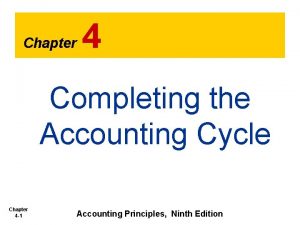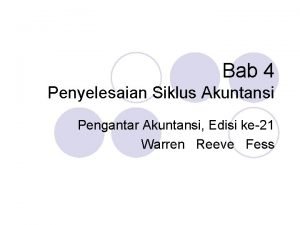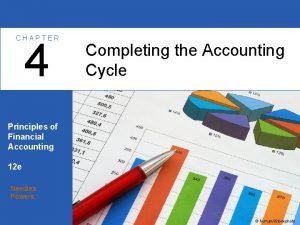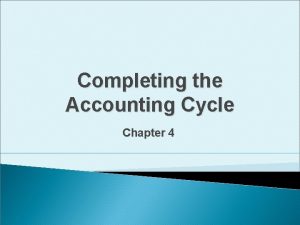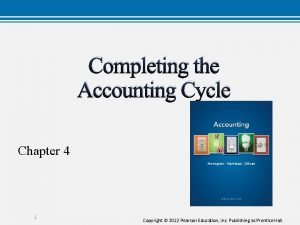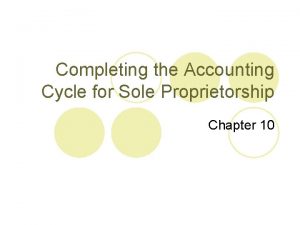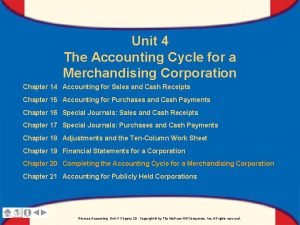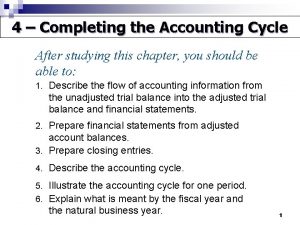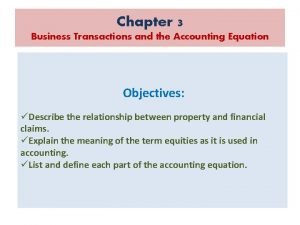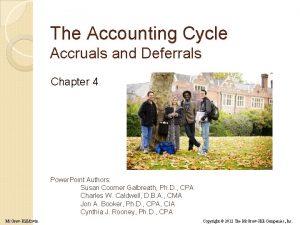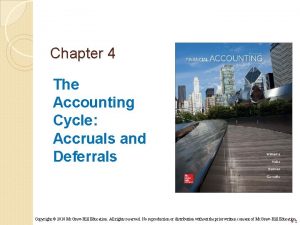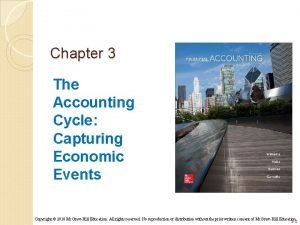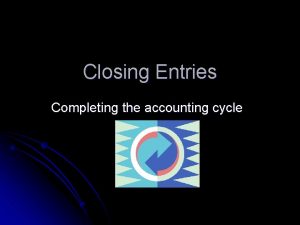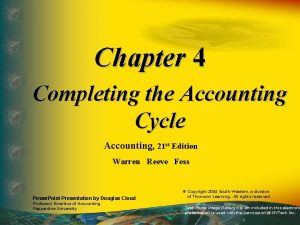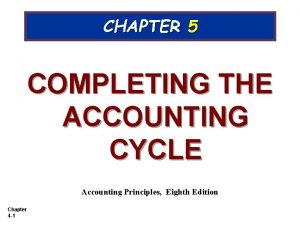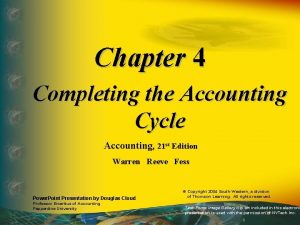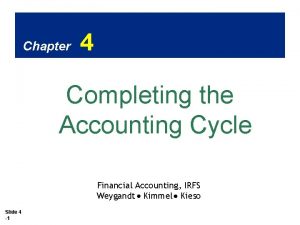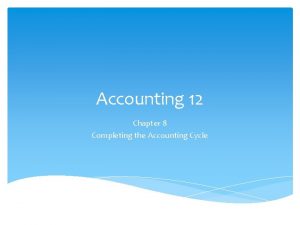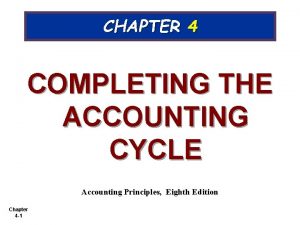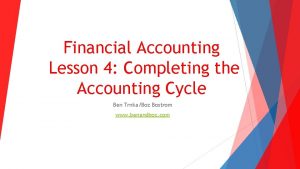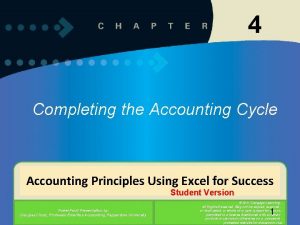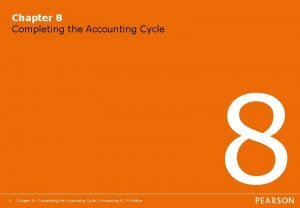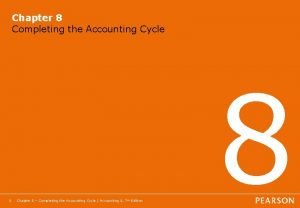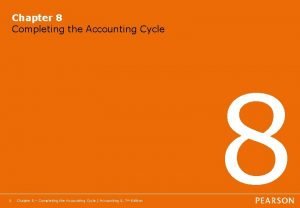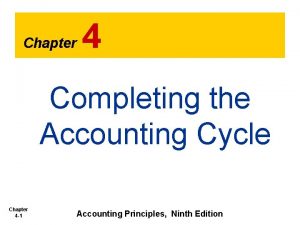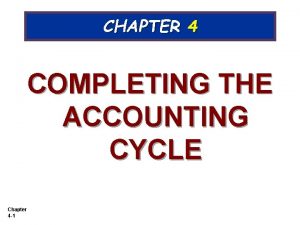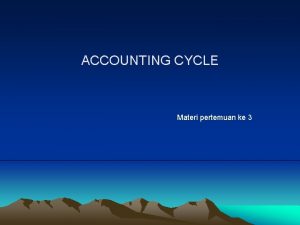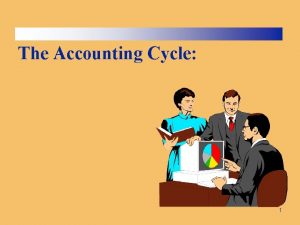Chapter 6 Completing the Accounting Cycle for a






































- Slides: 38

Chapter 6 - Completing the Accounting Cycle for a Service Business D. Reid

Adjustments • Financial statements need to be accurate. Adjustments are accounting changes recorded to make sure that all account balances are correct.

Adjusting the Books • Let’s say that some workers worked overtime or received bonuses but they were not recorded. Expenses would be too low and salaries payable (liability) would be too low. It is necessary for an adjusting entry to be made to adjust the amount in these accounts to reflect the correct amount.

Prepaid Expenses • Prepaid expenses are expenses that are paid for in advance. They are classified as current assets (since you have already paid them – it becomes an asset – it is now an item of value to the company). Examples: prepaid rent, insurance, and supplies).

Prepaid Expenses • When a prepaid item is used up (ex. prepaid rent) the value needs to move out of asset (since it is not longer an item of value because we just used it up) and into an expense account. We do this by recording an adjusting entry.

Prepaid Expenses • At the end of an accounting period entries are made to record the conversion of prepaid assets to expenses, to correct the balances for the balance sheet, and to record the appropriate expenses for the period on the income statement. These entries are called adjusting entries.

Prepaid Rent • Cool Company is required to pay for three months rent at a time. This was something in the lease agreement that was signed when they moved into the space they are renting. • Each months rent is $1 700, so every three months they write a cheque for $5 100 (paying in advance for three months rent $1 700*3=$5 100).

Prepaid Rent • Since they are paying for something they have not used yet we are not going to put this into an expense account – it is going to go into a prepaid rent account.

Prepaid Rent

Prepaid Rent • At the end of each month we need to take the amount for rent for one month out of prepaid rent and put it into an expense account.

Prepaid Rent

Supplies • This is another prepaid account. When a company purchases supplies they are not all used up in one day – but at the end of the month there a lot less supplies than at the beginning of the month (if no new supplies were purchased).

Say Cool Company buys $700 worth of supplies sometime in April.

Supplies • Every day small amounts of supplies are used up (paper, pens, staples, tape, etc. ). • It would be a full time job and very unnecessary for someone to record each time a piece of paper was used, but we do have to account for it sometime. • We account for all of the supplies that were used up at the end of a fiscal period (each month).

Supplies • To figure out how much you have to adjust for in the supplies account at the end of the month you first need to see how much supplies you still have.

Supplies • Cool Company estimated to have $600 worth of supplies left at the end of April so we figure out that we need to make an adjusting entry for $100 worth of supplies that were used up (we don’t have any longer). • Amount we started with $700 • Amount we have left -$600 • Amount to adjust $100

Supplies

Prepaid Insurance • Cool Company got an insurance policy in January that covers them for fire, theft, and accidental damage and the cost is $720 each year.

Prepaid Insurance

Prepaid Insurance • At the end of the month (Jan), one month’s insurance has been used up and must be recorded as an expense. • To figure out the amount that needs to be recorded take the total and divide it by 12 since there are twelve months in a year. • $720/12 = $60 each month

Prepaid Insurance

Depreciation • Cool Company purchased office equipment for $12 000 on April 14. Examples of office equipment include machines used to run the business, computers, fax machines, photocopiers, etc. We would record the following transaction:

Depreciation

Depreciation • Expenses are the cost of items used to produce revenue for a business. If you purchase a piece of equipment that you will use to run your business as you use it it becomes an expense to the business.

Depreciation • Example: Cool Company buys a photocopier for $12 000 that it will use for five years and then it will probably be worthless. However, the equipment doesn’t all of a sudden at the end of five years become worthless – it loses some of its value each year. A portion of the cost of the equipment should be assigned or allocated as an expense each year.

Depreciation • The matching principle states that revenue and expenses need to be matched up in the period they occur and this goes along with this principle. • They are using up some of the equipment that they will use to create revenue for the company.

Recording Depreciation • Depreciation is the allocation of the cost of a fixed asset to the fiscal period in which it is used. Depreciation is an expense and will appear on the income statement. • To figure out the amount of depreciation you take the amount you paid for it and subtract what you think you can get for it and then divide it by the number of years you think you will use it for.

Recording Depreciation • In our case we don’t think we can get anything for the equipment at the end of the five years (it will be useless – no scrap value or trade-in value). So we take the amount we paid for it and divide it by the five years we think we will be able to use it for. $12 000/5 years = $2 400 each year.

Recording Depreciation • The entry to record the depreciation of the equipment at the end of the first year is:

Recording Depreciation • Depreciation Expense – Equipment – appears on the income statement in the expense section. • Accumulated Depreciation – Equipment – appears on the balance sheet in the fixed asset section. • Accumulated Depreciation is deducted from equipment (to more accurately reflect the assets of the business)

Recording Depreciation • On a balance sheet you would see:

Recording Depreciation • Depreciation is a method of spreading the cost of a fixed asset over the life of that asset. • Each fixed asset will have its own depreciation expense and accumulated depreciation account (that is why this one has Equipment after it). You can also use this for building, trucks, machines, etc.

Accumulated Depreciation • Accumulated depreciation is a “contra account”. • This is an account that offsets the value of another account. • In this case the accumulated depreciation – equipment account brought down the value of the equipment account.

Accumulated Depreciation • Book value is the cost of an asset minus the accumulated depreciation. • Here the book value would be $9 600

Methods of Calculating Depreciation • There are two common ways to calculate depreciation : 1. Straight –line method (this is the method I used in the previous slides) 2. Declining-balance method, fixed percentage

Straight Line Method • This method allocates the same amount of depreciation each fiscal period (ex. each year) • To figure out the amount of depreciation you take the amount you paid for it and subtract what you think you can get for it and then divide it by the number of years you think you will use it for.

Straight Line Method • Original cost – salvage value = total amount you use for depreciation • Total amount you use for depreciation/ number of years or months you will use it = amount to depreciate each year or month

Declining-Balance Method, Fixed Percentage • This method allocates a great amount of depreciation to the first years of an assets life. • Some would say this is more accurate (think of a car – it looses it’s value the most in the first few years). • Each year you are going to have a different amount to depreciate. • You calculate this by taking a percentage of the book value.
 Trial balance junior cert
Trial balance junior cert Chapter 4 completing the accounting cycle
Chapter 4 completing the accounting cycle Completing the accounting cycle chapter 4 pdf
Completing the accounting cycle chapter 4 pdf Chapter 4 completing the accounting cycle
Chapter 4 completing the accounting cycle Completing the accounting cycle chapter 4
Completing the accounting cycle chapter 4 Chapter 4 completing the accounting cycle
Chapter 4 completing the accounting cycle Closing entries for sole proprietorship
Closing entries for sole proprietorship Post closing trial balance for merchandising business
Post closing trial balance for merchandising business Completion of accounting cycle
Completion of accounting cycle John jones, capital
John jones, capital Intermediate accounting chapter 1
Intermediate accounting chapter 1 Chapter 4 the accounting cycle accruals and deferrals
Chapter 4 the accounting cycle accruals and deferrals Chapter 4 the accounting cycle accruals and deferrals
Chapter 4 the accounting cycle accruals and deferrals Chapter 3 accounting cycle
Chapter 3 accounting cycle Chapter 3 accounting cycle
Chapter 3 accounting cycle Chapter 5 principles of engine operation
Chapter 5 principles of engine operation 18:1 preparing for the world of work
18:1 preparing for the world of work Chapter 18 preparing for the world of work
Chapter 18 preparing for the world of work Fspos
Fspos Typiska drag för en novell
Typiska drag för en novell Tack för att ni lyssnade bild
Tack för att ni lyssnade bild Ekologiskt fotavtryck
Ekologiskt fotavtryck Varför kallas perioden 1918-1939 för mellankrigstiden
Varför kallas perioden 1918-1939 för mellankrigstiden En lathund för arbete med kontinuitetshantering
En lathund för arbete med kontinuitetshantering Adressändring ideell förening
Adressändring ideell förening Tidbok för yrkesförare
Tidbok för yrkesförare Anatomi organ reproduksi
Anatomi organ reproduksi Vad är densitet
Vad är densitet Datorkunskap för nybörjare
Datorkunskap för nybörjare Stig kerman
Stig kerman Debattartikel struktur
Debattartikel struktur För och nackdelar med firo
För och nackdelar med firo Nyckelkompetenser för livslångt lärande
Nyckelkompetenser för livslångt lärande Påbyggnader för flakfordon
Påbyggnader för flakfordon Tryck formel
Tryck formel Svenskt ramverk för digital samverkan
Svenskt ramverk för digital samverkan Jag har nigit för nymånens skära text
Jag har nigit för nymånens skära text Presentera för publik crossboss
Presentera för publik crossboss Argument för teckenspråk som minoritetsspråk
Argument för teckenspråk som minoritetsspråk

